Scientific name Tibouchina Rank Genus | ||
 | ||
Lower classifications Tibouchina urvilleana, Tibouchina mutabilis, Tibouchina semidecandra | ||
Propagating a tibouchina grandifolia plant glory flower
Tibouchina /ˌtɪbuːˈkaɪnə/ Aubl. is a Neotropical flowering plant genus in Melastomataceae Juss. that contains approximately 240 species. Species of this genus are herbs, shrubs or trees and typically have purple flowers. They are native to Mexico, the Caribbean, and South America where they are found as far south as northern Argentina. Members of this genus are known as glory bushes, glory trees or princess flowers. The name Tibouchina is adapted from a Guianan indigenous name for a member of this genus [2]. A recent systematic study has shown that this genus is paraphyletic.
Contents
- Propagating a tibouchina grandifolia plant glory flower
- Tibouchina granulosa purple glory tree
- Morphology
- Distribution and Invasive Potential
- Cultivation
- Ploidy
- Systematics
- Tibouchina sensu stricto
- Tibouchina aegopogon
- Tibouchina albescens
- Tibouchina araguaiensis
- Tibouchina aspera
- Tibouchina barbigera
- Tibouchina bipenicillata
- Tibouchina bruniana
- Tibouchina catharinae
- Tibouchina dissitiflora
- Tibouchina duidae
- Tibouchina edmondoi
- Tibouchina fraterna
- Tibouchina johnwurdackiana
- Tibouchina karstenii
- Tibouchina llanorum
- Tibouchina mathaei
- Tibouchina melastomoides
- Tibouchina nigricans
- Tibouchina papyrus
- Tibouchina sipapoana
- Tibouchina striphnocalyx
- Tibouchina verticillaris
- Selected species of Tibouchina sensu lato
- References
Tibouchina granulosa purple glory tree
Morphology
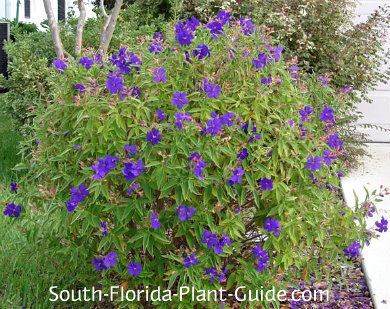
Members of Tibouchina sensu lato are diagnosed by a number of traits including pentamerous flowers with anthers having developed pedoconnectives (the connective tissue below the anther locules) and anther appendages that are ventrally bi-lobed. These traits are likely plesiomorphic in the core Melastomeae. The magenta or purple flowers are often showy, and the stamens may be dimorphic.
Distribution and Invasive Potential
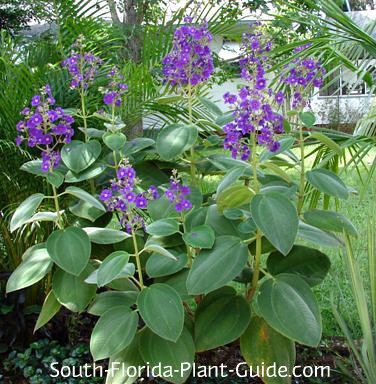
All 240 species of Tibouchina s.l. are native to the New World, with a large proportion found in Brazil. Many species of Tibouchina s.l. are found in the Mata Atlantica in eastern Brazil, while many others are found in the cerrado and campos rupestres. Members of Tibouchina sensu stricto tend to be found in lowland savannas and on the lower slopes of the Andes. All Tibouchina species are considered noxious weeds in Hawaii because of their high potential for being invasive species.
Cultivation
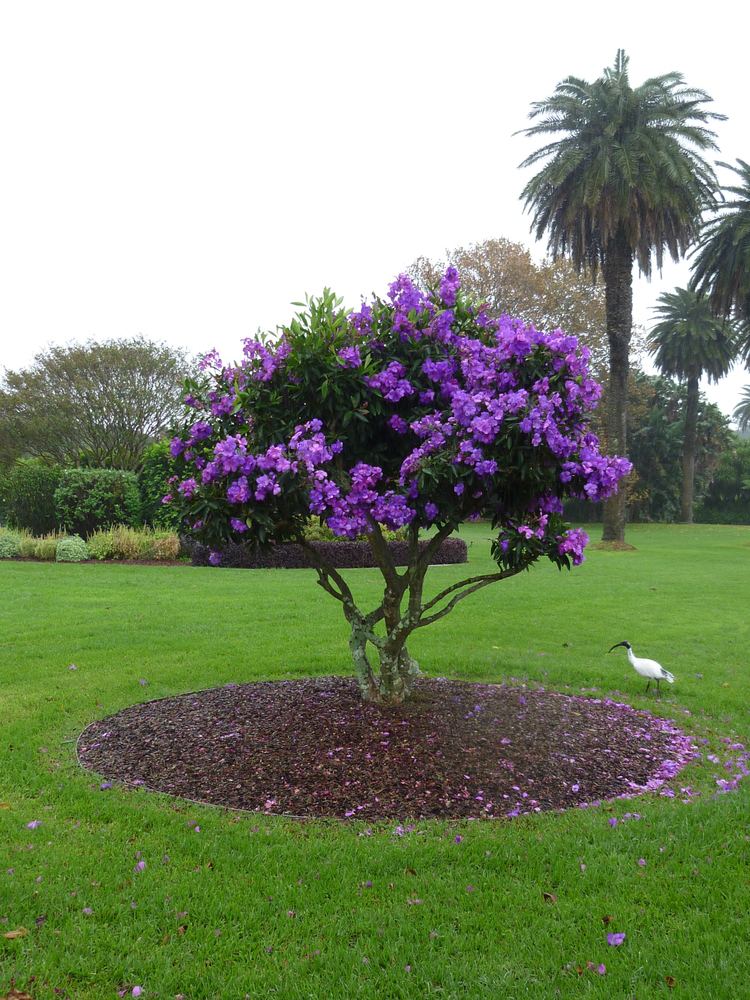
Several species are cultivated for their large bright flowers. As tropical plants they are rather cold-sensitive, and should be raised in a greenhouse wherever temperatures fall below 8 °C to 10 °C. One species, Tibouchina lepidota 'Alstonville', known for its brilliant display of flowers in late summer and autumn is common in many parts of Australia. In Australia, both this species and Tibouchina grandiflora and cultivars are commonly known as Lasiandra. They are closely related to a native shrub Melastoma affine also known as Native Lasiandra. All these plants are featured and celebrated in the annual Lasiandra Festival** held in the small country town of Wauchope, which is situated in the hinterland of the Central New South Wales Coast, City of Port Macquarie. Bright purple, the colour of the flowers, forms the central theme of the festivall. http://www.lasiandrafestival.com.au/
Ploidy
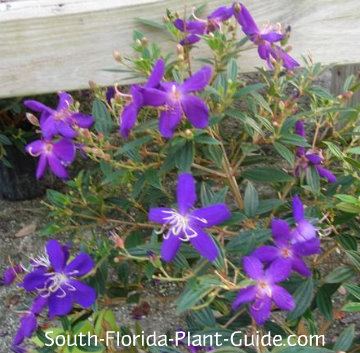
Over 30 species of Tibouchina s.l. have chromosome counts published. There is evidence for polyploidy in this group as the haploid number tends to fall in one of three classes: n=9, n=18 or n=27. This series of x=9 is quite consistent within Tibouchina although there are three documented deviations from this pattern. T. lepidota (Bonpl.) Baillon has been reported to have 2n =122 and n=62 in different studies, while T. semidecandra (DC.) Cogn has 2n =54 and T. urvilleana (DC.) Cogn has 2n =56. For species with chromosome counts, tetraploidy is most common (16 species) while 10 species are diploid and 4 species are hexaploid.
Systematics
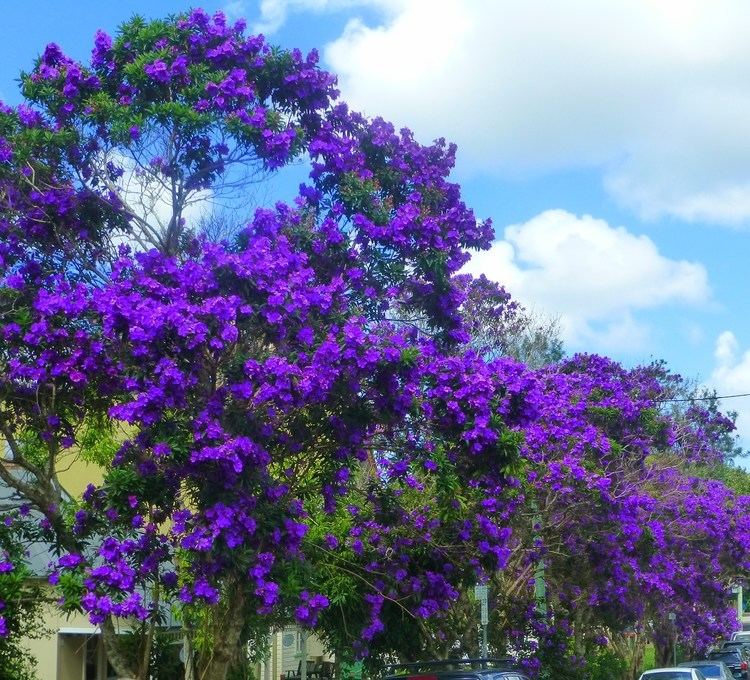
A phylogenetic analysis based on molecular data (2 plastid and 1 nuclear regions) determined that the traditional circumscription of Tibouchina is paraphyletic. Four major clades were resolved within the genus which are supported by morphological, molecular and geographic evidence. The type species, Tibouchina aspera Aubl., was first described in 1775 based on a specimen from French Guiana. Based on the traditional code of nomenclature, the clade that the type species falls in retains the name of the genus; therefore, the clade containing Tibouchina aspera is called Tibouchina sensu stricto. A taxonomic revision of the other clades of Tibouchina s.l. and related genera has not been published.
Tibouchina sensu stricto
Tibouchina s.s. Aubl. is a clade within the paraphyletic genus Tibouchina Aubl. This clade contains 22 species belonging to the traditional sections T. section Tibouchina and T. section Barbigerae. Diagnostic characteristics of Tibouchina s.s. include the presence of scale-like trichomes on the hypanthium and leaves and a long pedoconnective on lilac anthers, and the absence of glandular trichomes. These species are found in savanna habitats. The following species are currently considered to be included within Tibouchina s.s.:
Tibouchina aegopogon
Tibouchina aegopogon Cogn. was described in 1885. There are currently two described varieties: T. aegopogon var. angustifolia Cogn. and T. aegopogon var. aegopogon. T. aegopogon is found in Bolivia and Brazil. The type specimen is located at the Muséum National d'Histoire Naturelle in Paris.
Tibouchina albescens
Tibouchina albescens Cogn. ex PJF Guimaraes, ALF Oliveira & R Romero was formally described in 2015. The status of this name has been debated. The online resource Tropicos reports that Glaziou published the name in 1908 but according to Oliveira et al, no description or diagnosis was ever published so the name had not previously been validly published. T. albescens is found in Bolivia and Brazil. There is one published homonym for this species (T. albescens Wurdack).
Tibouchina albescens is a shrub from the Brazilian states of Goiás, Mato Grosso and Tocantins. It is found on rocky outcrops in the cerrado and campos rupestres at elevations between 600 and 1,400 metres, including in the Chapada dos Veadeiros National Park. This species is similar to T. verticillaris but has membranaceously peeling bark which reveals a white or silver wood underneath; there are also differences in the shape and density of trichomes and indumentum.
Tibouchina araguaiensis
Tibouchina araguaiensis PJF Guim is a shrub that has been found only in Araguaia National Park in the state of Tocantins, Brazil and was described in 2014. It grows in the transitional area between forest and meadows at 200 metres in sandy soil. This species is very similar to Tibouchina papyrus Distinguishing characters include the triangular hypanthial scales which cover the entire hypanthium, and the abaxial leaf surface which is only sparsely covered by ciliate scales; in T. papyrus, the prominent scales cover the entire lower leaf surface. These species also differ in their distribution; Tibouchina araguaiensis is found on the flat topography of Araguaia National Park, while T. papyrus is endemic to the higher elevation campos rupestres in southeast Tocantins and western Goiás.
Tibouchina aspera
Tibouchina aspera Aubl. is a subshrub with densely scaly indumentum on the stem, petiole, calyces and hypanthium. T. aspera was described in 1775 and is the type species of the genus Tibouchina. There are currently three synonyms for this species: Rhexia aspera (Aubl.) Willd., Tibouchina belizensis Lundell, and Tibouchina spruceana Cogn.. There are also two currently described varieties: T. aspera var. asperrima Cogn. and T. aspera var. aspera. This species was described in 1775 based on a specimen from French Guiana which is currently kept in the herbarium at the Natural History Museum in London. It was found growing in dry, arid and sandy soil close to an abandoned home. In the original description of this species, it was suggested that this plant was inhaled to treat chest pain and dry coughs. Now, this species is known to be widely distributed in Central and South America, including in Belize, Bolivia, Colombia, French Guiana, Guyana, Honduras, Nicaragua, Panama, Peru, Suriname, Venezuela, and in the Brazilian states of Amapá, Roraima, Amazonas, Pará, Acre, Rondônia, Maranháo, and Mato Grosso. It is commonly found in the cerrado, campinas and restingas in humid, sandy soil. In a study of the Melastomataceae of the Brazilian restingas in Pará, T. aspera was found in the herbaceous marsh, fields between dunes and open shrubby fields (Lima et al, 2014).
Tibouchina barbigera
Tibouchina barbigera Baill was described in 1877. It is a small shrub found in Bolivia and in the cerrado of Central Brazil. The type specimen is kept in the herbarium at the Muséum National d'Histoire Naturelle in Paris. T. barbigera is the host to a number of gall-inducing moths.
Tibouchina bipenicillata
Tibouchina bipenicillata (Naudin) Cogn. was described in 1885 and has one synonym: Lasiandra bipenicillata Naudin. It is found in Colombia, Costa Rica, Panama and Venezuela. The type specimen is kept in the herbarium at Conservatoire et Jardin botaniques de la Ville de Genève in Switzerland.
Tibouchina bruniana
Tibouchina bruniana PJF Guim was described in 2014. Distinguishing characteristics of Tibouchina bruniana are the solitary flowers (occasionally in dichasia) and the small leaves (< 2.5 cm long). The anthers have long, simple trichomes which led the authors to place this species in the section Barbigerae. This shrub is found in cerrado vegetation, growing in compacted soil and in swampy areas at around 1,100 metres. This species is only known from one population growing close to a nickel mine in the Brazilian state of Goiás.
Tibouchina catharinae
Tibouchina catharinae Pittier was described in 1947 and is found in Venezuela.
Tibouchina dissitiflora
Tibouchina dissitiflora Wurdack was described in 1958 and is found in Venezuela.
Tibouchina duidae
Tibouchina duidae Gleason was described in 1952 and is found in Venezuela.
Tibouchina edmondoi
Tibouchina edmondoi Brade was described in 1959 and is found in Brazil.
Tibouchina fraterna
Tibouchina fraterna NE Br. was described in 1901. There are currently two described subspecies: T. fraterna subsp. paruana Wurdack and T. fraterna subsp. fraterna. T. fraterna is found in Brazil, Guyana and Venezuela. One chromosome count has been done for this species with a gametophytic count of 9. The type specimen is kept in the herbarium at Botanischer Garten und Botanisches Museum Berlin-Dahlem, Berlin.
Tibouchina johnwurdackiana
Tibouchina johnwurdackiana Todzia was described in 1997 and the type specimen is kept in the herbarium at Missouri Botanical Garden.
Tibouchina karstenii
Tibouchina karstenii Cogn. was described in 1885 and is found in Colombia. The type specimen is kept at the Naturhistorisches Museum Wien in Austria.
Tibouchina llanorum
Tibouchina llanorum Wurdack was described in 1964 and is found in Bolivia, Brazil and Venezuela.
Tibouchina mathaei
Tibouchina mathaei Cogn. was described in 1885 and is found in Peru. There is one synonym for T. mathaei: Lasiandra lepidota Naudin. The type specimen is kept at the Muséum National d'Histoire Naturelle in Paris.
Tibouchina melastomoides
Tibouchina melastomoides Cogn was described in 1885 and is found in Brazil. The type specimen is kept in Naturhistorisches Museum Wien in Austria.
Tibouchina nigricans
Tibouchina nigricans Cogn ex PJF Guimaraes, ALF Oliveira, R Romero was described in 2015. The type specimens are kept at the Missouri Botanical Gardens and at Botanischer Garten und Botanisches Museum Berlin-Dahlem, Berlin.
Tibouchina nigricans is an short, unbranched shrub with a dark purple hypanthium and calyx lobes. T. nigricans is similar to T. aegopogon and T. johnwurdackiana as these species each have only a single stem, although there are distinguishing differences in the trichomes and indumentum of the leaves and hypanthium. This species is found in the states of Goiás and Distrito Federal in Brazil. It prefers open grassland including the campo sujo and cerrado rupestre. It has been found at elevations between 1,100 and 1,200 metres. T. nigricans is classified as endangered (IUCN category EN B2ab(iii)) and is only known from four collections. It has recently been found in Parque Nacional de Brasília and Serra dos Pireneus.
Tibouchina papyrus
Tibouchina papyrus Toledo was described in 1952. Tibouchina papyrus is a narrow endemic to the campos rupestres and is mainly found in three localities in the states of Goiás and Tocantins in central Brazil, including the Serra da Natividade. Abreu et al. found that T. papyrus is a habitat-specialist on rocky outcrop cerrado which typically has shallow substrate and uneven topography, with sandstone soils and quartzite outcrops
. This species has been collected at elevations between 500 metres and 1,100 metres. T. papyrus is listed as vulnerable by the IUCN. Tibouchina papyrus is locally known as “pau-papel”.
The flowers of T. papyrus are buzz pollinated by large bees in the genera Xylocopa, Bombus and Centris, and the seeds are wind dispersed (autochory). Flowers have higher fruit production when cross-pollinated although they are not self-incompatible and can produce low numbers of fruit when self-pollinated. One study of microsatellite loci showed low levels of polymorphism and low genetic diversity within populations, while another study found that populations of T. papyrus are highly differentiated with little to no gene flow between populations.
Tibouchina sipapoana
Tibouchina sipapoana Gleason was described in 1950 and is found in Venezuela.
Tibouchina striphnocalyx
Tibouchina striphnocalyx (DC) Gleason was described in 1950 and is found in Brazil and Venezuela. There are three synonyms for this species: Osbeckia striphnocalyx DC., Pterolepis striphnocalyx Mart., and Tibouchina yavitensis Pittier.
Tibouchina verticillaris
Tibouchina verticillaris Cogn was described in 1885 and is found in Brazil.
